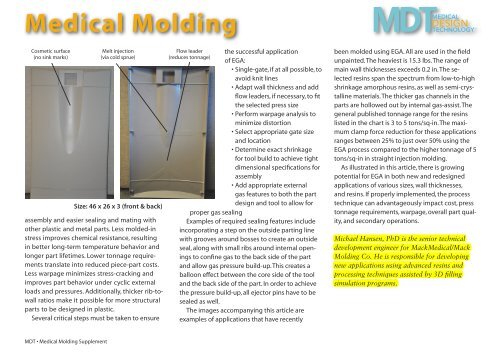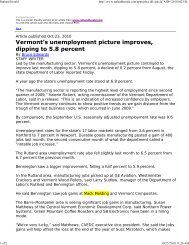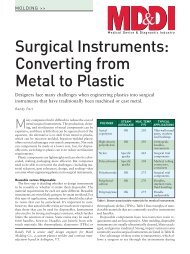Achieving Effective Process Monitoring Through ... - Mack Molding
Achieving Effective Process Monitoring Through ... - Mack Molding
Achieving Effective Process Monitoring Through ... - Mack Molding
Create successful ePaper yourself
Turn your PDF publications into a flip-book with our unique Google optimized e-Paper software.
Medical <strong>Molding</strong><br />
Cosmetic surface<br />
(no sink marks)<br />
Melt injection<br />
(via cold sprue)<br />
Size: 46 x 26 x 3 (front & back)<br />
assembly and easier sealing and mating with<br />
other plastic and metal parts. Less molded-in<br />
stress improves chemical resistance, resulting<br />
in better long-term temperature behavior and<br />
longer part lifetimes. Lower tonnage requirements<br />
translate into reduced piece-part costs.<br />
Less warpage minimizes stress-cracking and<br />
improves part behavior under cyclic external<br />
loads and pressures. Additionally, thicker rib-towall<br />
ratios make it possible for more structural<br />
parts to be designed in plastic.<br />
Several critical steps must be taken to ensure<br />
Flow leader<br />
(reduces tonnage)<br />
the successful application<br />
of EGA:<br />
• Single-gate, if at all possible, to<br />
avoid knit lines<br />
• Adapt wall thickness and add<br />
flow leaders, if necessary, to fit<br />
the selected press size<br />
• Perform warpage analysis to<br />
minimize distortion<br />
• Select appropriate gate size<br />
and location<br />
• Determine exact shrinkage<br />
for tool build to achieve tight<br />
dimensional specifications for<br />
assembly<br />
• Add appropriate external<br />
gas features to both the part<br />
design and tool to allow for<br />
proper gas sealing<br />
Examples of required sealing features include<br />
incorporating a step on the outside parting line<br />
with grooves around bosses to create an outside<br />
seal, along with small ribs around internal openings<br />
to confine gas to the back side of the part<br />
and allow gas pressure build-up. This creates a<br />
balloon effect between the core side of the tool<br />
and the back side of the part. In order to achieve<br />
the pressure build-up, all ejector pins have to be<br />
sealed as well.<br />
The images accompanying this article are<br />
examples of applications that have recently<br />
been molded using EGA. All are used in the field<br />
unpainted. The heaviest is 15.3 lbs. The range of<br />
main wall thicknesses exceeds 0.2 in. The selected<br />
resins span the spectrum from low-to-high<br />
shrinkage amorphous resins, as well as semi-crystalline<br />
materials. The thicker gas channels in the<br />
parts are hollowed out by internal gas-assist. The<br />
general published tonnage range for the resins<br />
listed in the chart is 3 to 5 tons/sq-in. The maximum<br />
clamp force reduction for these applications<br />
ranges between 25% to just over 50% using the<br />
EGA process compared to the higher tonnage of 5<br />
tons/sq-in in straight injection molding.<br />
As illustrated in this article, there is growing<br />
potential for EGA in both new and redesigned<br />
applications of various sizes, wall thicknesses,<br />
and resins. If properly implemented, the process<br />
technique can advantageously impact cost, press<br />
tonnage requirements, warpage, overall part quality,<br />
and secondary operations.<br />
Michael Hansen, PhD is the senior technical<br />
development engineer for <strong>Mack</strong>Medical/<strong>Mack</strong><br />
<strong>Molding</strong> Co. He is responsible for developing<br />
new applications using advanced resins and<br />
processing techniques assisted by 3D filling<br />
simulation programs.<br />
MDT • Medical <strong>Molding</strong> Supplement






